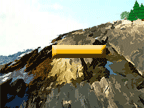 |
 |
|||||||||||||||
|
Another common gastropod in the mid intertidal, particularly in tide pools, is the tortoiseshell limpet, Tectura testudinalis. Related to the periwinkle, the limpet lacks a spiral shell. They move over the rock surface grazing on young seaweeds with a radula like the periwinkles. The limpet's radula is a bit tougher though, they are designed to excavate and shovel the algae into their mouths. For a lesson in limpet anatomy, click on the image above right. There's no place like home for the limpet. When the tide goes out, the limpet will move back to an original position on the rock, known as a "home scar." The limpets grinds at the rock so that a tight seal is made. On soft rock, the abrasion between the limpet shell and the rock results in the formation of a shallow depression or ‘home scar' in the rock surface. On hard rock, the shell will be worn down to make it fit perfectly into the rock. The limpet clamps the rock tightly with its large foot trapping water under their shell. Creating a moist environment under its shell allows the limpet to breathe and not dry out while exposed to the air. Limpets prefer to settle and feed on the coralline crust algae, Clathomorphum. This animal and algae have a special relationship called mutualism. The limpet gets a constant source of food and a smooth surface to feed from. The algae benefits by having its surface cleaned by the limpet. Without the limpet, Clathomorphum would suffocate under debris and faster growing algae would overtake its space. |
||||||||||||||||
Know the science lingo... |
||||||||||||||||
|
||||||||||||||||



